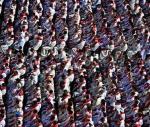You are here
Jordan economic growth 'slightly on rise' this year — EBRD
By Mohammad Ghazal - May 10,2018 - Last updated at May 10,2018
DEAD SEA — Jordan's economy is expected to witness a slight increase in 2018, reaching 2.5 per cent against the backdrop of an improved outlook for the tourism sector and higher revenues from the sale of phosphates and other mining products, a report by the European Bank for Reconstruction and Development (EBRD) showed.
Jordan's economic growth is forecast to reach 2.7 per cent in 2019, after 2 per cent in each of the previous two years, the EBRD said in a report launched Wednesday during the bank's 27th annual meeting and business forum at the Dead Sea.
“Jordan’s economy is expected to see a modest increase in the pace of growth this year, supported by stronger private consumption driven by a rising population of refugees and the implementation of structural reforms,” the EBRD’s Regional Economic Prospects report stated, highlighting a positive impact from the government’s programme to offer citizenship to foreign investors under certain conditions, an improved global outlook and higher confidence stemming from fiscal consolidation.
“The rate of growth in Jordan remained subdued in 2017 at 2 per cent, below the average of 2.5 per cent recorded between 2010 and 2016, a period when the instability in Iraq and Syria and the large influx of Syrian refugees — estimated at 1.3 million — curbed growth. This is compared to an average growth of 6.3 per cent between 2001 and 2010,” the report indicated.
In 2017, the modest growth was driven by services (transportation, financial services and real estate), the strong rebound in mining and the slight pick-up in manufacturing and agriculture, while construction continued to slow down. Tourism arrivals increased by 7.8 per cent, for the first time since 2010, resulting in the best tourism season since the Arab Spring.
The EBRD pointed to several future risks, including the potential for slippage in the roll-out of reforms under the International Monetary Fund programme, and the possibility of protracted conflict in Syria and Iraq which are Jordan’s main export markets.
The economy could also come under pressure from a further increase in the arrival of refugees and tighter liquidity in Gulf Cooperation Council countries, which are typically a source of funding for Jordan, the report said, noting that a surge in the US dollar would undermine competitiveness.
On the upside, any involvement of Jordanian businesses in the future reconstruction of Syria and Iraq would positively support growth.
Jordan’s exports would benefit from higher mining output, rising phosphate prices and the reopening in 2017 of the border with Iraq, the report stated, noting that growth in the EBRD regions averaged 3.8 per cent year-on-year in 2017. The acceleration, now sustained for two years, has been broad-based, with contributions from stronger investment activity and higher exports.
Average growth in the region may now have peaked, according to the report, which said it is expected to moderate to 3.3 per cent in 2018 and 3.2 per cent in 2019.
Despite the projected deceleration, the expected average growth in 2018-19 will be higher than in 2014-16, the report said, noting that the projections are in line with moderate estimates of potential medium-term growth in EBRD regions, which, in turn, reflect the lower levels of productivity growth compared with those seen before the 2008-09 crisis as well as adverse demographic trends.
Related Articles
AMMAN – The European Bank for Reconstruction and Development (EBRD) on Wednesday said growth forecasts for the southern and eastern Mediterr
AMMAN — The European Bank for Reconstruction and Development (EBRD) is forecasting modest economic growth in 2023 in the southern and easter
AMMAN — The European Bank for Reconstruction and Development (ERBD) forecasts Jordan’s economy to grow by 2.3 per cent in 2017 and by 2.5 pe

















